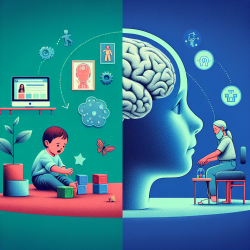Introduction
In the realm of speech-language pathology, understanding the multifaceted causes of communication disorders is crucial for effective intervention. A recent study titled "Causative effects of cranial depression fractures: A case study of structural violence and social vulnerability within the Mississippi state asylum" provides valuable insights into how structural violence and cranial depression fractures (CDFs) can affect individuals' neurological and developmental health. This blog explores the implications of this research for practitioners, particularly those working with children, and emphasizes the importance of a holistic approach in therapy.
The Link Between CDFs and Developmental Issues
The study highlights a case from the Mississippi State Lunatic Asylum, where an individual with a cranial depression fracture exhibited developmental challenges, including difficulties in understanding spoken and written language. This underscores the potential impact of CDFs on brain areas critical for language processing and cognitive development.
For speech-language pathologists, this information is vital. It suggests that children with a history of head trauma, even if not immediately apparent, may experience language and cognitive difficulties. Understanding the potential neurological underpinnings can guide more targeted and effective interventions.
Structural Violence and Social Vulnerability
The concept of structural violence, as discussed in the research, refers to the societal structures that systematically disadvantage certain groups, leading to poor health outcomes. This framework can be applied to understand the broader context of a child's life, including access to healthcare, education, and socioeconomic status.
Speech-language pathologists can benefit from considering these factors when assessing and treating children. By acknowledging the role of structural violence, practitioners can advocate for comprehensive support systems that address not only the immediate therapeutic needs but also the environmental factors contributing to a child's challenges.
Implications for Practice
- Holistic Assessment: Incorporate questions about a child's medical history, including any head injuries, in assessments. Understanding the full context of a child's background can reveal underlying issues affecting their development.
- Interdisciplinary Collaboration: Work closely with other professionals, such as neurologists and psychologists, to create a comprehensive care plan that addresses both the physical and social aspects of a child's life.
- Advocacy and Education: Educate families and communities about the potential impacts of head injuries and the importance of early intervention. Advocate for policies that reduce structural barriers to accessing quality healthcare and education.
Encouraging Further Research
The study opens avenues for further research into the long-term effects of CDFs on child development and the role of structural violence in perpetuating health disparities. Practitioners are encouraged to contribute to this body of knowledge by documenting and sharing their observations and outcomes in therapy.
To read the original research paper, please follow this link: Causative effects of cranial depression fractures: A case study of structural violence and social vulnerability within the Mississippi state asylum.










